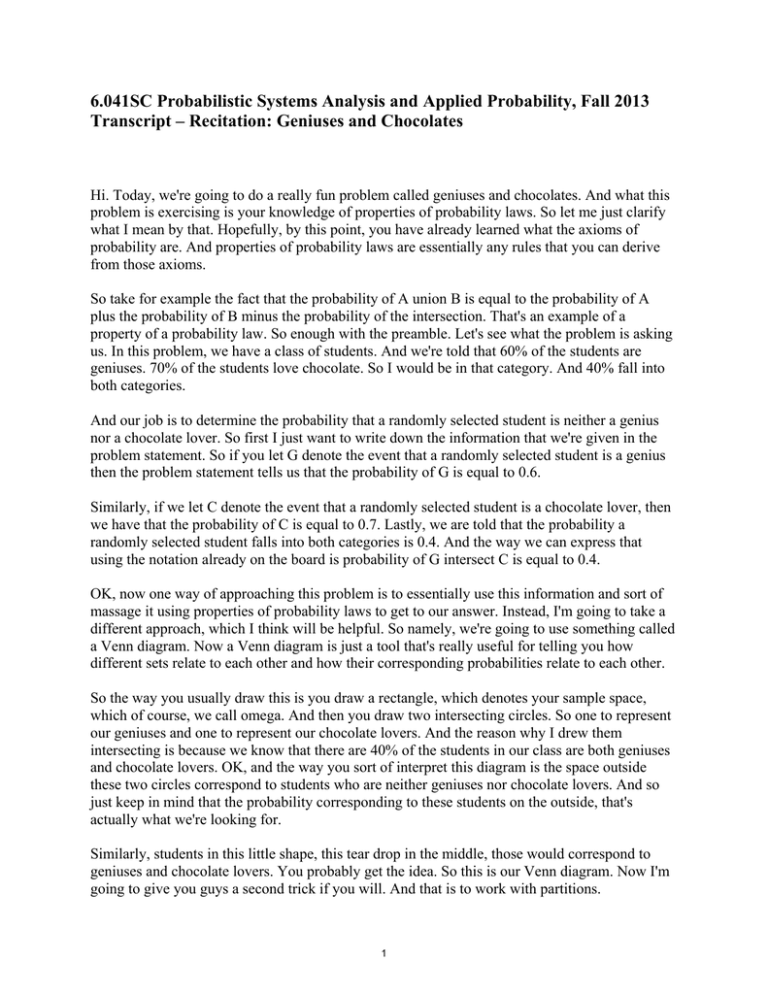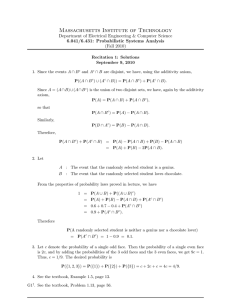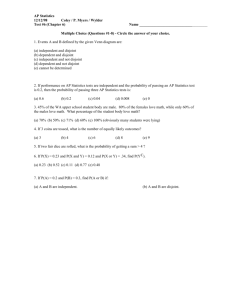6.041SC Probabilistic Systems Analysis and Applied Probability, Fall 2013
advertisement

6.041SC Probabilistic Systems Analysis and Applied Probability, Fall 2013 Transcript – Recitation: Geniuses and Chocolates Hi. Today, we're going to do a really fun problem called geniuses and chocolates. And what this problem is exercising is your knowledge of properties of probability laws. So let me just clarify what I mean by that. Hopefully, by this point, you have already learned what the axioms of probability are. And properties of probability laws are essentially any rules that you can derive from those axioms. So take for example the fact that the probability of A union B is equal to the probability of A plus the probability of B minus the probability of the intersection. That's an example of a property of a probability law. So enough with the preamble. Let's see what the problem is asking us. In this problem, we have a class of students. And we're told that 60% of the students are geniuses. 70% of the students love chocolate. So I would be in that category. And 40% fall into both categories. And our job is to determine the probability that a randomly selected student is neither a genius nor a chocolate lover. So first I just want to write down the information that we're given in the problem statement. So if you let G denote the event that a randomly selected student is a genius then the problem statement tells us that the probability of G is equal to 0.6. Similarly, if we let C denote the event that a randomly selected student is a chocolate lover, then we have that the probability of C is equal to 0.7. Lastly, we are told that the probability a randomly selected student falls into both categories is 0.4. And the way we can express that using the notation already on the board is probability of G intersect C is equal to 0.4. OK, now one way of approaching this problem is to essentially use this information and sort of massage it using properties of probability laws to get to our answer. Instead, I'm going to take a different approach, which I think will be helpful. So namely, we're going to use something called a Venn diagram. Now a Venn diagram is just a tool that's really useful for telling you how different sets relate to each other and how their corresponding probabilities relate to each other. So the way you usually draw this is you draw a rectangle, which denotes your sample space, which of course, we call omega. And then you draw two intersecting circles. So one to represent our geniuses and one to represent our chocolate lovers. And the reason why I drew them intersecting is because we know that there are 40% of the students in our class are both geniuses and chocolate lovers. OK, and the way you sort of interpret this diagram is the space outside these two circles correspond to students who are neither geniuses nor chocolate lovers. And so just keep in mind that the probability corresponding to these students on the outside, that's actually what we're looking for. Similarly, students in this little shape, this tear drop in the middle, those would correspond to geniuses and chocolate lovers. You probably get the idea. So this is our Venn diagram. Now I'm going to give you guys a second trick if you will. And that is to work with partitions. 1 So I believe you've seen partitions in lecture by now. And a partition is essentially a way of cutting up the sample space into pieces. But you need two properties to be true. So the pieces that you cut up your sample space into, they need to be disjoint, so they can't overlap. So for instance, G and C are not disjoint because they overlap in this tear drop region. Now the second thing that a partition has to satisfy is that if you put all the pieces together, they have to comprise the entire sample space. So I'm just going to put these labels down on my graph. X, Y, Z, and W. So X is everything outside the two circles but inside the rectangle. And just note, again, that what we're actually trying to solve in this problem is the probability of X, the probability that you're neither genius, because you're not in this circle, and you're not a chocolate lover, because you're not in this circle. So Y I'm using to refer to this sort of crescent moon shape. Z, I'm using to refer to this tear drop. And W, I'm using to refer to this shape. So, hopefully, you agree that X, Y, Z, and W form a partition because they don't overlap. So they are disjoint. And together they form omega. So now we're ready to do some computation. The first step is to sort of get the information we have written down here in terms of these new labels. So hopefully, you guys buy that G is just the union of Y and Z. And because Y and Z are disjoint, we get that the probability of the union is the sum of the probabilities. And, of course, we have from before that this is 0.6. Similarly, we have that the probability of C is equal to the probability of Z union W. And, again, using the fact that these two guys are disjoint, you get this expression. And that is equal to 0.7. OK, and the last piece of information, G intersects C corresponds to Z, or our tear drop, and so we have that the probability of Z is equal to 0.4. And now, if you notice, probability of Z shows up in these two equations. So we can just plug it in. So plug in 0.4 into this equation. We get P of Y plus 0.4 is 0.6. So that implies that P of Y is 0.2. That's just algebra. And similarly we have point. 0.4 plus P of W is equal to 0.7. So that implies that P of W is 0.3. Again, that's just algebra. So now we're doing really well because we have a lot of information. We know the probability of Y, the probability of Z, the probability of W. But remember we're going for, we're trying to find the probability of X. So the way we finally put all this information together to solve for X is we use the axiom that tells us that 1 is equal to the probability of the sample space. And then, again, we're going to use sort of this really helpful fact that X, Y, Z, and W form a partition of omega to go ahead and write this as probability of X plus probability of Y plus probability, oops, I made a mistake. Hopefully, you guys caught that. It's really, oh, no. I'm right. Never mind. Probability of X plus probability of Y plus probability of Z plus probability of W. And now we can go ahead and plug-in the values that we solved for previously. So we get probability of X plus 0.2 plus 0.4 plus 0.3. These guys sum to 0.9. So, again, just simple arithmetic, we get that the probability of X is equal to 0.1. So we're done because we've successfully found that the probability that a randomly selected student is neither a genius nor a chocolate lover is 0.1. So this was a fairly straightforward 2 problem. But there are some important takeaways. The first one is that Venn diagrams are a really nice tool. Whenever the problem is asking you how different sets relate to each other or how different probabilities relate to each other, you should probably draw Venn diagram because it will help you. And the second takeaway is that it's frequently useful to divide your sample space into a partition mainly because sort of the pieces that compose a partition are disjoint. So we will be back soon to solve more problems. 3 MIT OpenCourseWare http://ocw.mit.edu 6.041SC Probabilistic Systems Analysis and Applied Probability Fall 2013 For information about citing these materials or our Terms of Use, visit: http://ocw.mit.edu/terms.





